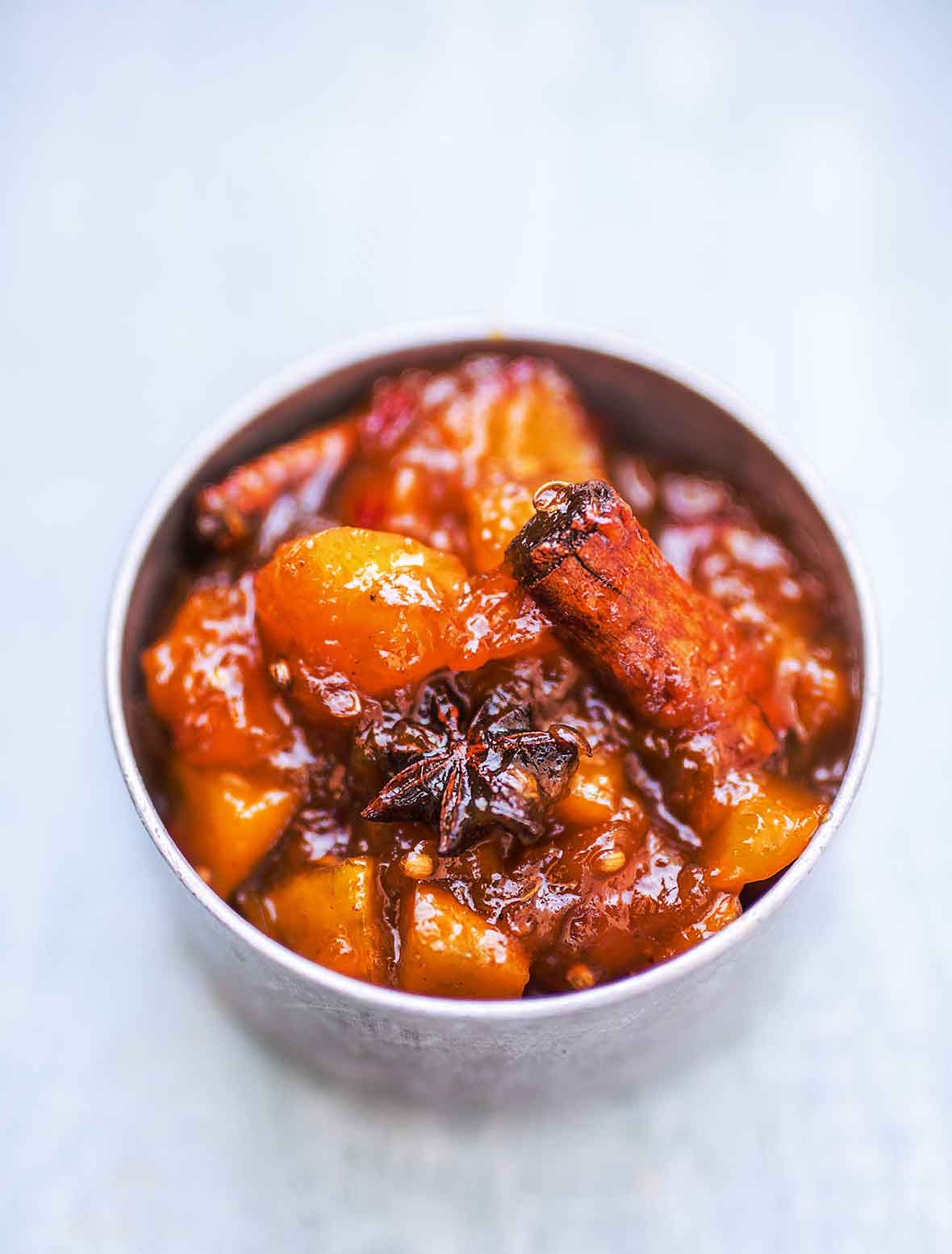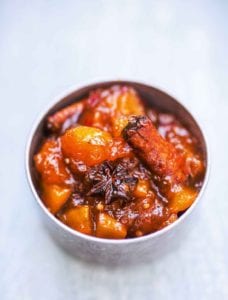
Mango chutney is an easy and authentic, sweet and spicy condiment made of mango, chile pepper, and a spectacular combination of Indian spices. It’s easy as can be to make and its uses are nearly endless—spoon it atop grilled meat or fish, schmear it on toast, fold it into an omelet, or fancy up your cheese plate. Heck, it’s so darn good you may just find yourself spooning it up straight from the jar.–Angie Zoobkoff
Want to Save This?

Mango Chutney
Equipment
- Canning jar and lid; cheesecloth (optional)
Ingredients
- 1 pound unripe green mangoes (or mangoes that are as unripe as possible), washed
- 1 tablespoon mild vegetable or olive oil
- 1 large red chile, finely diced
- One (2-inch) cinnamon stick
- 2 teaspoons coriander seeds
- 8 green cardamom pods, cracked
- 5 cloves
- 2 star anise
- 1 cup cold water
- 1/2 teaspoon garam masala
- Generous 3/4 cup unrefined brown sugar
- 1/2 teaspoon sea salt
- 2 to 3 tablespoons apple cider vinegar (optional)
Instructions
- Peel the mangoes and discard the skins. Slice the fruit away from the pit and then cut the fruit into 3/4-inch (2-cm) dice.
- Place a heavy-bottomed saucepan over medium heat and add the oil. Toss in the chile, cinnamon, coriander seeds, cardamom, cloves, and star anise and cook for 30 seconds. (If you have cheesecloth, first bundle the whole spices in the cloth before tossing them in the pan.) Add the mango chunks, water, garam masala, sugar, and salt. If your mangoes are fairly ripe and sweet, add the vinegar. Bring to a boil and gently cook, uncovered and stirring frequently, until the chutney is nice and thick with very little liquid remaining and the liquid that is remaining is no longer runny, anywhere from 50 to 80 minutes. You’ll need to stir the chutney more and more frequently toward the end of cooking to ensure it doesn’t stick to the pan and scorch.
- Remove the pan from the heat and let it cool for 10 minutes. If using cheesecloth, remove and discard the bundle of spices. If not using cheesecloth, you may wish to remove the whole spices with a spoon. Spoon the slightly cooled chutney into a clean jar. Let cool to room temperature before screwing on the lid and stashing the chutney in the fridge. (The chutney will keep for up to several weeks.)

Explore More with AI
Nutrition
Nutrition information is automatically calculated, so should only be used as an approximation.
Recipe Testers’ Reviews
Who knew you could make chutney at home? We’re so impressed with the simplicity of this recipe coupled with its outstanding flavor, we have to give it a gold star! This is one for the recipe box. In fact, it’s so simple, delicious, and beautiful that I may end up making it for Christmas gifts next year! The recipe was simple and came together easily. As usual, the most labor was spent measuring, peeling and chopping. Once the ingredients were ready, it literally took about 2 minutes to put it together on the stove top. We brought it to the boil and reduced to a simmer and then set the timer for 10-minute intervals. Every 10 minutes we would check the progress, stir, and reset the timer until the chutney was “done.” The simmering process took a full hour. I used 1 tablespoon cider vinegar as our mango wasn’t all that sweet but the amount of brown sugar kind of put it in the cloyingly sweet area. If I make it again, I will heat the spices in the oil as directed but then place them in a cheesecloth so they can be removed later. We found the crunch of the whole spices distracting in some cases and just unpleasant in others. Being able to easily remove the spices would help with this (although it would diminish the beautiful presentation with the star anise floating there). I would probably decrease the amount of sugar but I don’t know if the amount used is needed to create the “jam-like” consistency. It just seemed much sweeter than the chutneys we are used to.
I’m not sure which was better—the finished taste or the cooking aroma of this lovely chutney. The chile adds some heat which is a great contrast against the sweet fruit and sugar, and the combination of spices makes this a winning condiment. I used it alongside a spicy lamb curry, but I think it would also be fantastic atop some grilled chicken or firm white fish. I used a jalapeno instead of a red chile since that’s all that I could find. I partially seeded it and this resulted in a perfect amount of heat for us. Cook time was accurate at 1 hour to make a thick chutney. The chutney didn’t really begin to thicken noticeably until the 45 minute mark and it did need to be stirred frequently after that. At the 1 hour point, there was very little liquid left, mostly just soft fruit sort of melded together. Overall, fantastic flavor. The combination of all the spices really makes it special.
Chutney for me is always associated with mango and curry. I also use it with some pork and meat dishes. This is an easy-to-make and delicious recipe. It has visible chunks of mango all through it, soft but with all that sweet and sour taste given by the sugar and vinegar and a great combination of spices that gives it a rich flavor. I used a red cayenne chile pepper and 2 tablespoons cider vinegar.
With its exotic combination of flavors, this mango chutney was easy to make and we quickly used it all up. The chutney had a nice “bite” to it. Lucky for me, I bought extra mangoes and so I’ll make it again soon. The only direction I found vague was whether my mango was too sweet. I did use the apple cider vinegar. I like the taste of the chutney straight but used it all up in two recipes—a cheese ball and cocktail meatballs.
After lunch at an Indian restaurant coupled with a trip to the Indian grocer, we went home to make this chutney. We had set the stage well and this was an easy way to prolong the wonderful lunch experience. We used a serrano chile pepper and no apple cider vinegar. The serrano pepper, while a lovely red color in the chutney, did nothing for spicing up the flavor. We agreed that it needed a little more zip and squirted in a splash of Sriracha, not once, but twice, tasting in between so as not to overpower the chutney. It did, in fact, make a small jarful, and, as a condiment, the number of servings is largely dependent on how much you use as an accompaniment to a dish and what that dish is. Since we didn’t put a lid on it right away, it was easy to grab a spoon and have a little nibble while walking by or when opening up the fridge, and the whole small jar could easily disappear while snacking this way. My short list of ways to use this include as a condiment with Indian food, on crackers with cream cheese, on a cheese plate or tray, on toast, as a side to scrambled eggs or inside of an omelet, or tucked inside of a grilled cheese sandwich. When I asked my chutney-tasting partner, she suggested adding it to sandwiches, in or on white bean dip, in black bean soup (I especially love this one!), over raw oysters, with sautéed white fish, and puréed into vinaigrette for a salad served with Indian food.













From the start of making this mango chutney recipe, I fell in love with all the beautiful aromas. My home smells wonderful! And the flavors…just magic! There is the sweet, then all the spices, the savory, and a little kick in the end from the chile. I used a red chile pepper from my kitchen garden (don’t know the kind…). My chutney became nice and thick after 50 minutes of gentle cooking. Makes one small jar (1 cup). It’s so delicious that even my 13-year-old boy said he would eat the entire jar! Next time I will make more! It’s delicious on toast, with grilled meat, or just spooned from the jar. We’re all sad it’s finished.
Wow! The 13-year-old’s approval is huge! Love that, Joana!